Little room for error: small retail business in general and in DC in particular
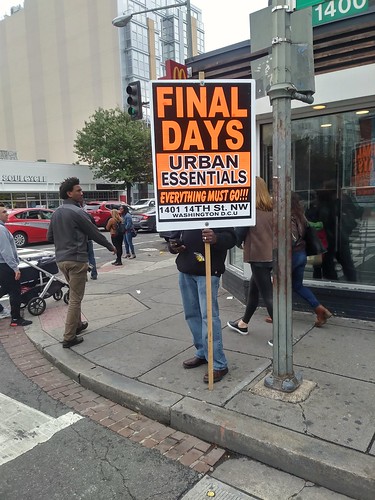 Last week, Washington Post writer Paul Schwartzman had a piece, "Amid prosperity, D.C.'s independent retailers struggle to survive," on the seeming increase in failure of small retail businesses in the city.
Last week, Washington Post writer Paul Schwartzman had a piece, "Amid prosperity, D.C.'s independent retailers struggle to survive," on the seeming increase in failure of small retail businesses in the city.Years ago, I took him around (actually, he wore me out) to look at popups -- third floors on traditional rowhouse buildings -- for a story.
And later he interviewed me for a story he wrote about the impact of property assessment rates ("Feeling the Pinch Of D.C.'s Prosperity"), something I had been agitating about for years. I stopped testifying about after awhile after realizing that Councilmembers didn't really care to understand why the problem existed.
-- "Avoiding the real problem with DC's property tax assessment methodologies," 2007
-- "Testimony -- Historic Neighborhood Retail Business Property Tax Relief Act," 2006
-- "Forcing Displacement by the disconnection of tax assessment models from public policy goals," 2005
-- "Displacement of retail businesses through increasing property tax assessments," 2005
-- "Revisiting the issue of neighborhood commercial district property tax methodologies," 2013
After Paul's 2007 article, I had a letter to the editor about it, re-emphasizing the point about the disconnect between property values, therefore tax rates, and the value of properties in terms of their revenue capacity in terms of sales/square foot.
My letter in the Post from July 25, 2007But while I think the fact that DC commercial retail rents are too high, and that commercial property tax rates -- shaped by the fact that the Central Business District is a national-international real estate market, which reprices value beyond local considerations, and this ends up shaping the value of commercial property across the city, whether or not the commercial district is a part of the national or international real estate market -- independent store owners have other problems.
Tax Policy Hurts D.C.'s Local Businesses
A July 20 Metro Article ["Feeling the Pinch of D.C.'s Prosperity: Small Businesses Cry Out for Relief From Rapid Rise in Property Taxes"] inadequately explained why tax assessments are rising for small commercial property owners in the District.
Regardless of buildings' locations and use, the D.C. Office of Tax and Revenue values commercial buildings as if they could be converted into downtown office buildings. If the purpose is to turn the entire city over to office buildings and retail chains, then this property tax assessment methodology is working.
The market for downtown property is not local; it involves national and international developers, lenders, and portfolio investors. The market for small-footprint buildings in neighborhood commercial districts is local--in terms of property owners, investors, tenants, sales potential and rents. The solution is simple: differentiated tax assessment methods.
The legislative focus on property tax abatements or tax caps fails to address this fact.
As a result, locally owned businesses will continue to close or relocate to the suburbs, while more and more of the retail identity and uniqueness of the District is lost and the city's retail landscape becomes reshaped into yet another mall, albeit outdoors, featuring national brands.
For example, Dupont Circle and Cleveland Park properties are often owned by national firms, whereas properties Downtown, Georgetown, and Friendship Heights involve both national and international firms.
Years ago, in the entry "Why ask why? Because," I discussed store operations in terms of various "mixes." But it's about more than that. Here's what I think is a more comprehensive list of the conditions faced by independent businesses:
1. Rents are too high relative to sales. The metric is that a business should pay no more than 4% to 10% of gross revenue in rent, although restaurants pay up to 15%. In malls and large commercial buildings owned by major firms, after a certain point, tenants also pay out as rent a portion of total revenue.
Based on a calculation of estimated sales per square foot, you can figure out the gross revenue potential of a space, and calculate what the rent "should be" on that basis.
-- "Cleveland Park Retail: My off-hand evaluation, the rents are too high," 2009
-- "Commercial retail rents #2," 2009
At best, a store has a gross profit of 20% before taxes. Paying more than 10% of gross revenue in rent pretty much wipes out profit.
(2. Property taxes for retail space are too high generally and in neighborhood commercial districts specifically.)
3. Size of the Market. DC isn't that big, about 700,000 residents. The number varies, but the average resident supports up to 7.5 s.f. of retail space.
Yes, the daytime population swells, but office workers have a very limited range of stuff that they buy, mostly prepared meals, and convenience goods. A number I've used for years, derived from an economic research firm, said the average office worker supports 2 s.f. of retail and 5 s.f. of quick service food. Although in the DC context, one study for the SW Ecodistrict found that about two-thirds of federal workers bring their lunch.
Tourists add to the mix, but mostly spend on food and lodging, and some retail. The lines at Georgetown Cupcake or the busy restaurants at Washington Harbor in Georgetown when often the food isn't that great, demonstrates the value of tourism to retail and restaurant spending in DC.
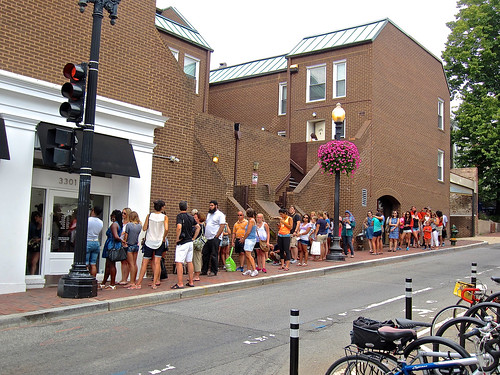
People in line at Georgetown Cupcake. Flickr photo by Robby Virus.
4. Too much retail space overall. With that 7.5 s.f/resident metric, DC can support upwards of 5 million square feet of retail space + some calculation for the spending by daytime office workers and districts.
There is much more retail space than that in the city. E.g. on 14th Street and H Street NE likely there is more than one million s.f. in each place.
Nationally this is the case too, especially vis a vis the impact of e-commerce. The US has 4x the retail space per person as the UK or other countries. That's why so many chains are going under, or closing stores.
5. Constant addition of new retail districts and space to the city footprint. While in some respects the city is under-stored compared to the suburbs, the addition of new retail districts like The Wharf , Navy Yard, City Center in Downtown, and Ivy City puts pressure on existing districts, without there necessarily being a commensurate increase in the overall customer base. Granted some of this space serves regional markets and tourist segments and isn't fully dependent on DC residents for success.
(Some of this space is sold on the belief that because it's located on commuter routes out of the city it will draw non-resident shoppers, but for the most part, most shoppers do their shopping nearer to home and not as part of work trips.)
Similarly, the impact of re/new/ed entertainment districts such as H Street or Ivy City puts pressure on existing districts like Adams-Morgan or Georgetown.
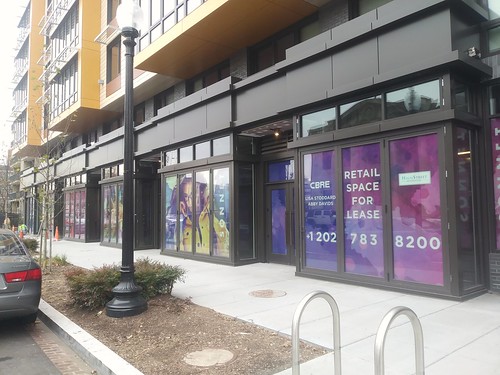
New retail space at the Sonnet mixed use building on the 1400 block north side of U Street NW, Washington, DC.
Every new mixed use building adds more supply to the retail space inventory. But it just isn't in big new districts as greyfield developments.. It's in most every place where new "mixed use" buildings are created, with retail on the ground floor. For example, this new building on the 1400 block of U Street NW is in place of a parking structure. It adds housing above, but new retail on the ground floor, where none had previously existed. While you can argue it will help strengthen the U Street streetscape, tying together north and south and drawing from the energy of 14th Street, it still is adding space likely beyond the demand.
6. Consolidation and chaining of the retail industry. Independents are hurt by how the retail sector has become dominated by chains, which enjoy special treatment by vendors, banks, and laws.
One way to counter this is to join buying groups and business services cooperatives, but not all independent stores do this.
7. Competition/Fit of the business model/lack of robust concept and operations model. Chances are good that there are other stores selling the same types of goods, so to be successful, a store has to have a good "value proposition." That might not necessarily be price, it can be quality, service, experience, etc.
-- "Why ask why? Because," 2007
-- "Retail and restaurant check up surveys," 2009
-- "An update to Richard's Rules for Restaurant-Based Revitalization on the failure of wine bar restaurants in DC and Baltimore," 2018
Plus some places may not be that great anyway. That's why I recommend that more commercial district revitalization organizations contract out for independent third-party evaluations of retail businesses, such as what are called "mystery shopper" evaluations.
-- "Critical analysis and critical analysis of retail, communities, etc.," 2014
(See table below.)
8. The impact of e-commerce. Online purchasing shaves off upwards of 10-20% of sales -- and more in certain categories such as office supplies and electronics, and has completely destroyed other categories altogether, such as travel -- reducing the revenue stream, profit margins, and flexibility to face downturns.
9. Location. Not all submarkets in the city can support every type of retail category or even multiple stores in particular categories. This gets back to the size of market point, but also a recognition that some commercial districts are "regionally serving" in that they serve multiple neighborhoods and include anchors that draw beyond the immediate neighborhood (and need to do so in order to be successful).
The smallest districts tend to support convenience retail -- food, pharmacy, hardware, gasoline -- and might have one or two specialty stores that may also serve as destinations, e.g. a store specializing in antique lighting in Cleveland Park, etc
10. Lack of differentiated commercial district coordination mechanisms. DC has Business Improvement Districts or Main Street programs. There are plenty of areas that need something different
-- "The "soft side" of commercial district competition," 2006
Typically, across the nation, Business Improvement Districts function in large city commercial districts, especially "Downtown." Some of the most prominent BIDs in the US are in New York City and Philadelphia, along with DC's Downtown DC BID. The main actors in BIDs are the property owners.
Main Street groups typically are present in smaller towns and in neighborhood commercial districts that don't have a lot of office buildings.
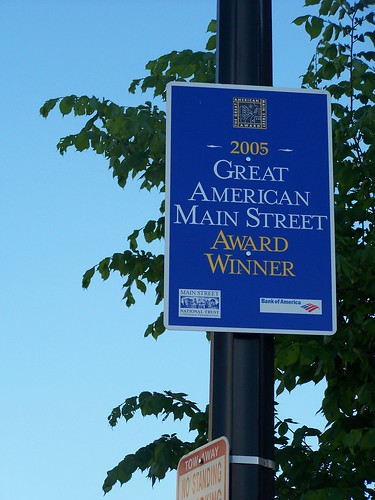 The Main Street approach is different from the BID approach in that residents and other stakeholders who don't necessarily own businesses in the commercial district are drawn into the organization, to broaden the range of skills and volunteers able to work on issues. (In my experience, Main Street volunteers tend to be 10-15 years younger than typical historic preservation group members, and live within a couple blocks of the main commercial street.) DC began a city Main Street program in 2002.
The Main Street approach is different from the BID approach in that residents and other stakeholders who don't necessarily own businesses in the commercial district are drawn into the organization, to broaden the range of skills and volunteers able to work on issues. (In my experience, Main Street volunteers tend to be 10-15 years younger than typical historic preservation group members, and live within a couple blocks of the main commercial street.) DC began a city Main Street program in 2002.A hybrid of the BID and Main Street approach is the "Community Improvement District," a special service district (that's what BIDs are) that covers both commercial and residential areas. Baltimore has a couple, and one in particular, Charles Village, has been very contentious with a group of residential property owners who resent paying towards the SSD. California has a lot more types of these districts, especially in San Francisco.
But I have also written about the BIDs in San Diego, which are somewhat unique, in that they use the BID funding mechanism--a fee per $100/property value--but tend to use the more ground up "Main Street Approach" to shape the programming and orientation of the organization.
So the commercial district revitalization organizations in San Diego have the advantage of steady funding from a property tax assessment like a BID, but the broader organizational, programming, and volunteer structure of a Main Street program. See "Let's Assess the Assessments" from the San Diego Reader.
That's a form that we're missing in DC, and ultimately the lack of steady funding has been the biggest problem for neighborhood commercial district revitalization organizations in the city. But also some districts need marketing and business support, but not necessarily the Main Street model, etc.
11. Store sizes are too big relative to sales.. National chains have been buffeted by these changes too and one of the things they are doing besides closing stores or going out of business is shrinking store size.
This reduces inventory and the amount of money tied up in it, increases focus on better selling items that sell more quickly, and reduces fixed costs for rent and variable costs for labor, utilities, etc.
====
In short, I think that many of the stores mentioned in the Schwartzman piece have multiple issues, not usually just one. Rent/commercial retail property issues are only two.
From "Retail and restaurant check up surveys":
------------------------------------------------------------------------------------------------
Principles for creating complete concepts/identity systems for retail businesses*
------------------------------------------------------------------------------------------------
• Understand the needs, preferences, habits, and aspirations of the target audience.
• Good design sells. It is a competitive advantage. Design is systems and processes, not just graphics.
• A disciplined, coherent approach leads to a unified and powerful brand presence.
• Create a distinct position and complete identity for your store/concept.
• Experience and study the competition and learn from their successes and failures.
• Understand traffic flow, the volume of business, and economic considerations of your location.
• The storefront is a mass communications medium that works 24/7 and can attract new customers, influence purchasing decisions, and increase sales.
• Logo and signage expresses the brand and builds on understanding the needs and habits of users in the environment.
• Exterior signage must consider both vehicular and pedestrian traffic.
• Design an interior space that is sustainable, durable, easy to maintain and clean, and is energy efficient.
• Consider the dimensions of space: visual, auditory, olfactory, tactile, and thermal.
• Understand the pyschological effect of light and lighting sources.
• Consider the needs of handicapped customers and those of different ages.
• The shelf is the most competitive marketing environment that exists.
• Align merchandising strategies with displays, advertising, and sales strategies.
• Create an experience and environment that makes it easy for customers to buy, and that inspires them to come back again and again.
• Create an environment that helps the sales force sell and makes it easy to complete a transaction.
• Align the quality and speed of service with the experience of the environment.
• Benchmark the quality and speed of service against the competition.
• Consider all operational needs so that the store delivers on the brand promise.
• Anticipate future growth. Measure, evaluate, change. Constantly ask: is the message clear?; is the content accessible?; is the experience positive?
* This table was built from the section on "creating touchpoints" from Designing Brand Identity (second edition) by Alina Wheeler
Retail's tough in general. But people eat more than they buy stuff. The Restoration Hardware in Georgetown, once one of the company's signature stores, is now a Wawa convenience store ("awa is coming to Georgetown. Bid farewell soon to Restoration Hardware," Washington Business Journal).
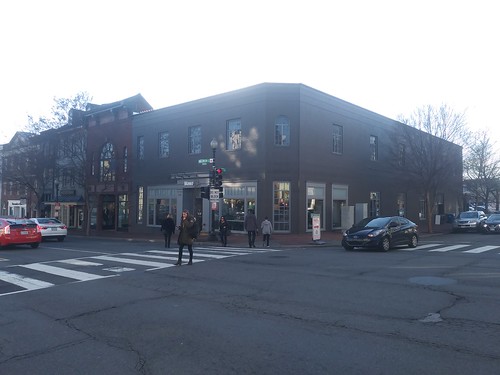
Labels: commercial district revitalization, retail, retail business promotion, retail enterpreneurship development, retail planning



2 Comments:
4 part series in Shelf Awareness e-letter on bookstore business, on independent stores and the rents issue:
https://shelf-awareness.com/search.html?sitesearch=%22Booksellers+Navigate+Rising+Rents%22&search=search
I remember back when I was the program manager for Main Street in Brookland DC, and discussing the prospects for a bookstore (my idea then was to get CUA to move its bookstore to 12th St. NE, instead they moved it to the new development on Monroe St.).
I pointed out that the typical gross margin on a book is 40% and from that 40% all the variable costs have to be paid -- labor, rent, taxes, utilities...
Hi everyone, Are you into trading or just wish to give it a try, please becareful on the platform you choose to invest on and the manager you choose to manage your account because that’s where failure starts from be wise. After reading so much comment i had to give trading tips a try, I have to come to the conclusion that binary options pays massively but the masses has refused to show us the right way to earn That’s why I have to give trading tips the accolades because they have been so helpful to traders . For a free masterclass strategy kindly contact maryshea03@gmail.com for a free masterclass strategy. She'll give you a free tutors on how you can earn and recover your losses in trading for free..
Post a Comment
<< Home